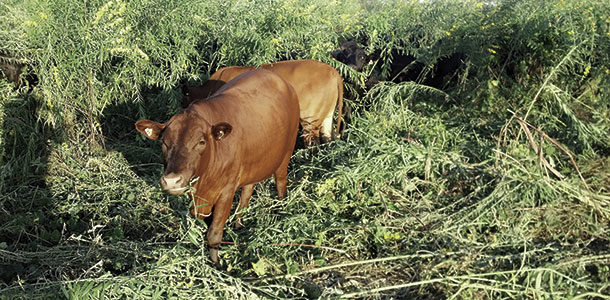The ground was doused in Roundup at least twice a month along with a cocktail of other chemicals. The ground was covered in fabric, compacting the soil. Nutrients were drawn from the soil without adequate replacements.
The result was a worn, white and sandy soil barely able to sustain plant life with an extremely low stocking rate. Soil organic content was dangerously low, and soil pH reached 6.2.
After the farm converted to ranching, a paddock was planted with ryegrass and, despite the application of commercial fertilizer, the weedy plants barely made it to 4 inches in height before dying back. Low soil fertility meant the 550 acres of pasture were barely able to sustain 163 animals.
In April 2012, Jim Elizondo, an agronomy engineer with a ranch of his own in Tampico, Mexico, was hired as cattle manager to revitalize the soil and the ranch. Elizondo has worked a multi-pronged, sustainable plan to improve the ranch literally from the ground up.
One of Elizondo’s first steps was to cease the chemical bombardment. Instead of Roundup and commercial fertilizer, he switched to an organic compost extract along with liquid fish and molasses.
Elizondo said, “We started seeing improvement immediately because when you use the compost extract the grass grows, but the humus content takes a long time to form and the humus content is the real fertility of any soil.”
One of the fastest ways to improve humus is through increased root activity and decay. To that end, Elizondo plants nearly half of the available pasture with cover crops, beginning with the worst paddocks.
Elizondo has found that cover crops not only produce a good yield per acre, but they also help improve the soil. He has found legumes especially efficient at improving chemically damaged soil. However, the best results don’t come from legumes alone but a mixture of species.
“You have to picture the different species in your mind. How they will start growing? How will they interact at different stages? You want them to complement each other, not destroy each other. Some compete for the same space or sunlight or moisture.
Some have deep roots, and some have shallow roots. We need them all because a mixture compensates for individual weaknesses so much better than a monoculture,” Elizondo says.
With that in mind, Elizondo plants some of the paddocks in his summer cover-crop mix including cowpea, sunn hemp, Egyptian wheat, Irish clover, brown millet and pearl millet, among others.
He hit upon this combination with research, trial and error to see what species worked best in his specific environment.
The cover crops grow well, reaching more than 8 feet before Elizondo sends in the cattle to graze. After the cattle have grazed, he plants another mixture of winter annuals behind the animals, including several varieties of clover, radishes and black oats.
Between trampling and the root activity to improve the soil humus, he has seen marked improvement in just three years.
Elizondo says, “Some people don’t want to use cover crops because they want to do it the traditional way or think it will cost too much, but that’s a mistake. They don’t see the improvements they could get.”
“They think nothing of spending $200 in hay and supplements per cow per year when they could only spend $70 per cow and carry more cattle” Elizondo says.
Elizondo uses a combination of cover crops, traditional grazing and rotating paddocks of stockpiled winter pasture. Though he supplements the cows with a protein meal for two winter months, no other supplements or additional hay are needed.
As the process has improved the soil, Elizondo has seen his stocking rate increase from one cow per 4 or 5 acres to one cow per 1.5 acres.
Elizondo says, “The main determinant of profitability on a ranch isn’t conception rates or price of the cows you sell. The number one determinant is the number of cows you can carry in a sustainable way.”
When asked about the dramatic improvement, Elizondo not only credits fertilizers, cover crops and grazing management, but the cattle themselves. “Cattle have two purposes,” Elizondo says, “the first is to convert grass to beef efficiently. The second is to improve the soil on which they graze.”
To that end, Elizondo uses a specially adapted cattle breed called Mashona, which means property of the Shona people. This breed was developed in Africa, which gives them some unique traits Elizondo has used to help improve the soil and the profitability of the ranch.
In Africa, the cows could only graze for 4 to 6 hours a day before being corralled to keep them safe from lions and other predators. Since the average cow takes about 8 hours to fill when grazing, this means that after 2,000 years, the cattle that survived were the ones who could eat the most during the shortest period.
This style of grazing also conditioned the breed to be nonselective grazers, as there’s no time to be picky when the lions are licking their chops. Elizondo has found the combination of hardiness, early maturation and nonselective grazing to be ideal for his operation.
The heat-resistant Mashona breed even allows Elizondo to have a summer calving season to take advantage of the natural forage cycle.
“You don’t have to pamper them and you can still get the same results. We couldn’t calve in the summer without them. We would have to supplement more, and that would cost more money.
We also couldn’t force another breed to graze nonselectively because they would drop in body condition, but the Mashona can do it because they are used to it. If we didn’t have the Mashona, it would be much more expensive and would take more time to improve the soil,” Elizondo says.
Cows aren’t the only animals pitching in to help improve the soil. Elizondo also encourages healthy insect activity both aboveground and belowground.
Once the chemicals were cleaned from the soil, Elizondo has seen an increase in earthworms and beetles, both of which help increase the health of the soil. Other insects indicate a healthy system as well.
“Spiders are a very important determinant. The more spiders you have, the more stable the system is. When you apply chemicals, you kill the insects or they become toxic, and when the spiders consume them, they die.
So if you go out early in the morning when there is dew and turn toward the rising sun, you can see if you have a lot of spiderwebs or not. It’s a very important indicator of a healthy system,” Elizondo says.
The idea is to create as much biodiversity as you can, because the more diverse the system is, the more resilient it is. Elizondo is happy to say that the once nearly sterile land now not only supports the ranch, but wild turkeys, bald eagles, predator cats, songbirds and more.
Other indications of healthy soil are less objective. Elizondo says he monitors the color of the soil, watching as building humus slowly changes white sandy soil to a rich brown. The soil also mellows as it improves, retaining more water and thus reducing the need for irrigation. Even the smell lets him know how the soil is doing.
Elizondo says, “I look at land management more as an art than a science. I’m an agronomy engineer by training, but I have learned by doing it that it is better to rely on your observations and senses. You can feel and smell the earth, and if it smells like a forest, like good earth, that’s how it should smell.
Mostly agricultural soil doesn’t have any smell. As we’ve gone along, the smell gets stronger and stronger as the humus builds up and the soil improves.”
All of Elizondo’s efforts to build and enrich the soil are paying off. As the land has improved, so has the profitability, and Elizondo plans to continue improvements to make the land as fertile, stable and healthy as possible. FG
For more information on regenerative grazing practices, visit Jim Elizondo’s website Regengraze.
PHOTO
On reclaimed pasture, Florida producer Jim Elizondo uses cover crops, traditional grazing, rotational grazing and stockpiled winter pasture. Photo courtesy of Jim Elizondo.










